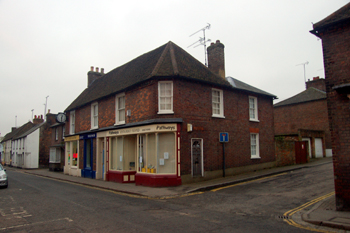Humbershoe Registration and Early References

48 High Street the former Bell Inn January 2010
In 1672 Charles II issued a Declaration of Toleration for Protestants dissenting from the Church of England; this had the effect of some dissenting meeting houses registering with the Secretary of State. The Toleration Act of 1689 enshrined the right of protestants to dissent from the Church of England and, once again, encouraged meeting houses to register voluntarily with local quarter sessions and Anglican church. Registration provided protection against persecution, laying a duty of protection upon magistrates and so was popular with nonconformists. Most registrations were made with quarter sessions until the middle of the 18th century, presumably due to the mutual antagonism of nonconformists and established Church. However, from that point registration with the Church, via the local archdeaconry began to become the favoured method, because the archdeaconry Registrar would issue a licence at any time rather than during the days each quarter when the quarter sessions met.
Visitations by the Bishop of Lincoln to Bedfordshire in the early 18th century give some idea as to the number of nonconformists in each parish from returns made by the vicar or rector. Former County Archivist Patricia Bell has compiled returns from 1706 to 1720 for the Bedfordshire Historical Records Society (Volume 81, published 2002). In 1706 the return noted that of forty families six were "Dissenters, Quakers and Anabaptists [Baptists]. But no Papist or reputed Papist". In 1709 of 180 souls 3 were stated to be Quakers, the rest Anabaptists. "There are two monthly meetings of the Anabaptists, one at market Street, the other within halfe [sic] a mile of the church". The number of dissenting families (Quakers and Anabaptists) had grown to eight or nine in 1717. There were no meeting houses. In 1720 the return stated: "Six [families] are Dissenters, and of the Sect called Baptists. There is no such Meeting House".
Bedfordshire Archives has a reasonable number of registrations of nonconformist meeting houses in both the Quarter Sessions and Archdeaconry of Bedford archives. Registration continued through the 19th century even though persecution faded away - this was because registered buildings were allowed to claim exemption from parish poor rates, were exempt from control by the Charity Commission and were allowed to be licensed to carry out marriages. These things meant that registration became almost compulsory in practice for well established nonconformist meetings. This is fortunate for the local historian because sometimes the only surviving references to a nonconformist meeting occur as registrations. One drawback with the registrations are that they do not usually inform the reader of the particular type of denomination involved, though sometimes it is possible to infer it from other evidence.
Volume 110 published by the Bedfordshire Historical Records Society in 1996 and edited by Edwin Welch contains registrations of Bedfordshire nonconformist meetings drawn from a number of sources. The only registration definitely in Humbershoe was in 1848 when the house and premises in occupation of Cornelius Goodyear in Market Streetwas registered by Robert Hodgert of Billington [refs: ABN1/2 and ABN2/397]. This property had, until a few years previously, beenTthe Bell Inn which is the only property in Humbershoe recorded as owned by Goodyear on the Tithe Apportionment plan and reference book of 1853 [refs: AT43/1 and MAT43/1].